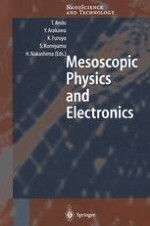Semiconductor technology has developed considerably during the past several decades. The exponential growth in microelectronic processing power has been achieved by a constant scaling down of integrated cir,cuits. Smaller fea ture sizes result in increased functional density, faster speed, and lower costs. One key ingredient of the LSI technology is the development of the lithog raphy and microfabrication. The current minimum feature size is already as small as 0.2 /tm, beyond the limit imposed by the wavelength of visible light and rapidly approaching fundamental limits. The next generation of devices is highly likely to show unexpected properties due to quantum effects and fluctuations. The device which plays an important role in LSIs is MOSFETs (metal oxide-semiconductor field-effect transistors). In MOSFETs an inversion layer is formed at the interface of silicon and its insulating oxide. The inversion layer provides a unique two-dimensional (2D) system in which the electron concentration is controlled almost freely over a very wide range. Physics of such 2D systems was born in the mid-1960s together with the development of MOSFETs. The integer quantum Hall effect was first discovered in this system.
